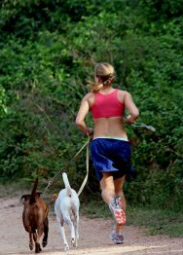 You would think that because we know how to crawl, walk and run that we would also innately know how to jog and race. That just isn’t the case. Running from one corner to the next does not mean you have the knowledge to design and execute a program that will take you from couch to 5k in several months. The most important thing to remember when you are beginning a running and jogging program is that this is a new sport. Just as you wouldn’t pick up a basketball, dribble twice and believe you could play like Michael Jordan, nor should you put on a pair of running shoes and believe you can run like Michael Green.
You would think that because we know how to crawl, walk and run that we would also innately know how to jog and race. That just isn’t the case. Running from one corner to the next does not mean you have the knowledge to design and execute a program that will take you from couch to 5k in several months. The most important thing to remember when you are beginning a running and jogging program is that this is a new sport. Just as you wouldn’t pick up a basketball, dribble twice and believe you could play like Michael Jordan, nor should you put on a pair of running shoes and believe you can run like Michael Green.
Instead, take the time to learn the basics, understand the execution and deliver the goods. You’ll be much happier in the long run, and so will your body!
Running and jogging takes a small toll on your body. Is this a negative toll? Only if you abuse your body and push it beyond your initial limits. As you continue to work at a sport that requires weight bearing through the legs and spine you’ll find that your bones will thicken from the stress, which will decrease your risk of osteoporosis as you grow older. Your tendons and ligaments will strengthen over time. Your cardiovascular ability will increase and your risk of stroke, diabetes, heart attack and immune mediated illness will decrease.
Here are several jogging tips that will keep you in tip top shape, decrease your risk of injury and keep you hungering for more and more time on the road.
 Jogging Tip #1: Have a plan! If you fail to plan then you plan to fail. Every good runner, even jogger, has a plan of action to improve at his sport. Especially when starting out at jogging and running have a written plan to follow.
Jogging Tip #1: Have a plan! If you fail to plan then you plan to fail. Every good runner, even jogger, has a plan of action to improve at his sport. Especially when starting out at jogging and running have a written plan to follow.
Jogging Tip #2: No matter how good you feel don’t push beyond your plan! The plan is there for a reason. One of the biggest mistakes that novice runners make is to push beyond the written plan on days they feel great. This only increases your risk of injury, makes your body weaker, and makes you question why you started this sport in the first place.
Jogging Tip #3: Your goal is FITNESS. Unless you are an elite endurance and performance athlete you should finish your workouts feeling great. Elite athletes may finish tired once or twice a week but they understand more than most that the body needs time to recover and repair before being able to be pushed again.
Jogging Tip #4: Warm up before each run. Running and jogging on cold muscles will decrease your performance, make you feel sluggish, decrease your motivation to continue and increase your risk of injury.
Jogging Tip #5: Wear the best running clothes for the weather. If you are running outside in the cold weather dress appropriately! Wear bright colors to stand out from the snow covered streets in the winter. Cover your head, your hands, your nose, your eyelids and the tips of your ears. Leave the house with enough clothing to feel slightly cold starting out so you don’t overheat when your body warms up. Head out into the wind so it’s at your back when you return and always carry a cell phone to reach help if it’s needed.
 Jogging Tip #6: In the summer wear light colored clothing, supportive material and carry water if the temperature is greater than 90 and you are running more than 20 minutes. If you are running in a neighborhood you may be able to ask some of the neighbors if you can stash a water bottle in their mailbox early in your run so as you pass by it’s there to quench your thirst – you won’t have to carry it the whole run.
Jogging Tip #6: In the summer wear light colored clothing, supportive material and carry water if the temperature is greater than 90 and you are running more than 20 minutes. If you are running in a neighborhood you may be able to ask some of the neighbors if you can stash a water bottle in their mailbox early in your run so as you pass by it’s there to quench your thirst – you won’t have to carry it the whole run.
Jogging Tip #7: Wear running shoes. Doesn’t matter if you are “just a jogger” or if you have your sights set on the local 5K or 10K race, running shoes are a must. Running and jogging doesn’t require much equipment but the sport specific equipment you do use is not negotiable. Running in cross trainers or tennis shoes increases your risk of injury to your legs, hips, knees and ankles as well as increasing the amount of pounding that the cartilage in your knees must endure.
Jogging Tip #8: If you can, run at least 60% of your time outdoors. Although the technology behind treadmills has come a long way it doesn’t take the place of running over the road or track. A treadmill decreases your energy expenditure while increasing your perceived exertion due to lack of distraction.
Jogging Tip #9: Cool down and stretch. This is often the part of the jogging routine that is over looked. You are done running, tired and hot. All you want is to pop in the shower and sit and relax for a few minutes. Don’t give in! Take about 5 minutes to walk and cool down and then another 10 minutes to stretch your quadriceps, hamstrings, gastrocs, glutes, IT band, adductors, triceps, biceps and shoulders. This will decrease the amount of lactic acid build up in the muscle and decrease how sore you may feel the next day. It will also improve your performance, increase the flexibility of the muscles and prevent injury.
Resources:
Dave Manuel: Beginners Guide to Jogging
http://www.davemanuel.com/2007/01/21/beginners-guide-to-jogging-how-to-get-started-and-how-to-avoid-injury/
NHS: Running Tips for Beginners
http://www.nhs.uk/Livewell/getting-started-guides/Pages/getting-started-running.aspx
Miami University: Jogging the Course
http://www.mid.muohio.edu/healtheu/actpdf/joggingprog.pdf
Runners World: Running Tips
http://www.runnersworld.com/training/running-tips
Cool Running: The Couch to 5K Running Plan
http://www.coolrunning.com/engine/2/2_3/181.shtml


Leave a Reply